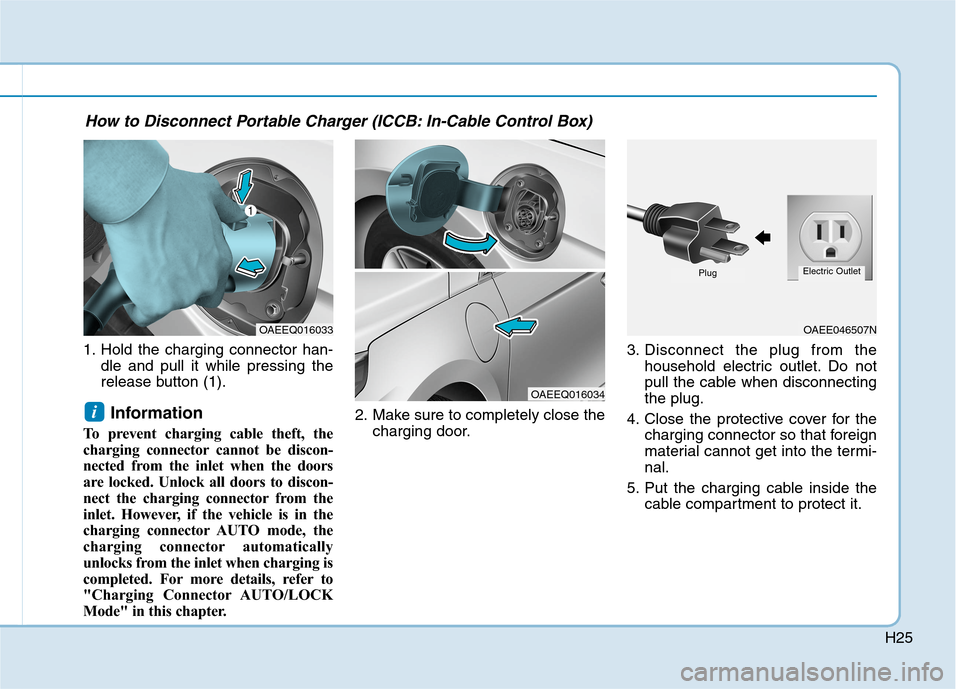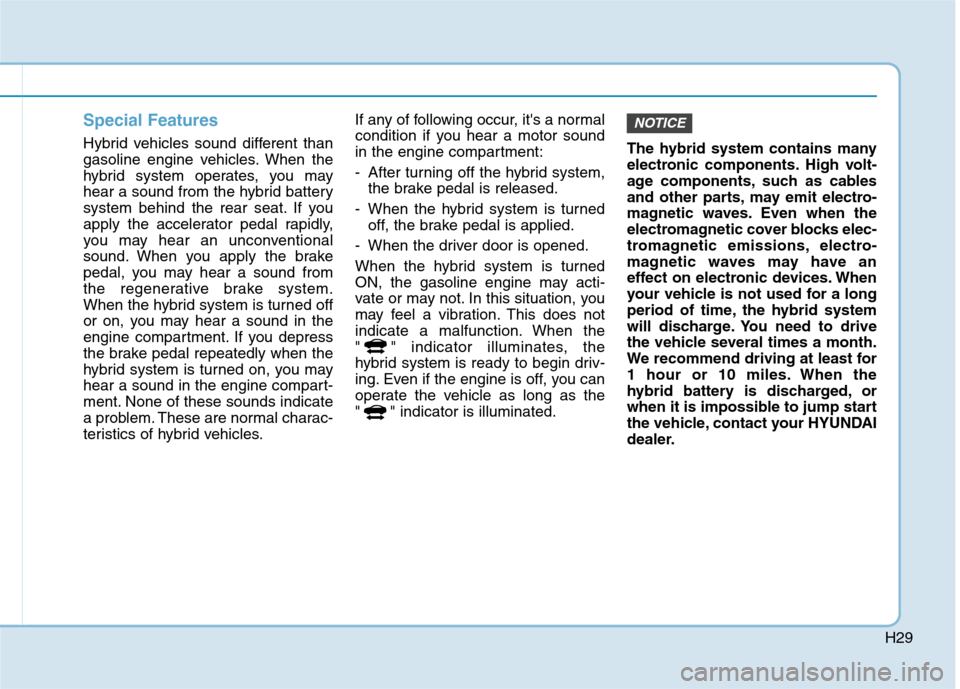Page 585 of 635
H14
C CH
HA
AR
RG
GI
IN
NG
G
T
TH
HE
E
P
PL
LU
UG
G-
-I
IN
N
H
HY
YB
BR
RI
ID
D
V
VE
EH
HI
IC
CL
LE
E
(
(C
CO
ON
NT
T.
.)
)
How to Disconnect AC Charger
1. When charging is complete,
remove the charging plug from the
electrical outlet of the AC charging
station.2. Hold the charging connector han-
dle and pull it while pressing the
release button (1).
Information
To prevent charging cable theft, the
charging connector cannot be discon-
nected from the inlet when the doors
are locked. Unlock all doors to discon-
nect the charging connector from the
inlet.
However, if the vehicle is in the charg-
ing connector AUTO mode, the charg-
ing connector automatically unlocks
from the inlet when charging is com-
pleted.
For more details, refer to "Charging
Connector AUTO/LOCK Mode" in
this chapter.
i
OAEEQ016033
OLFP0Q4057N
■ AC Charger
Page 586 of 635
H15
3. Make sure to completely close the
charging door.
Unlock Charging Connector in
Emergency
If the charging connector does not
disconnect due to battery discharge
and failure of the electric wires, open
the hood and slightly pull the emer-
gency cable. The charging connector
will then disconnect.
Trickle Charge
(1) Code and Plug (Code set)
(2) Control Box
(3) Charging Cable and Charging
Connector
Trickle Charge can be used when AC
Charge is not available by using
household electricity.OAEEQ016034
OAEPHQ016060
OAEEQ016042 ■Portable Charger
Page 589 of 635
H18
C CH
HA
AR
RG
GI
IN
NG
G
T
TH
HE
E
P
PL
LU
UG
G-
-I
IN
N
H
HY
YB
BR
RI
ID
D
V
VE
EH
HI
IC
CL
LE
E
(
(C
CO
ON
NT
T.
.)
)
2. Check if the power lamp (green)
illuminates on the control box.
3. Depress the brake pedal and
apply the parking brake.
4. Turn OFF all switches, shift to P
(Park), and turn OFF the vehicle.5. Press center edge of the charging
door to open the charging door.
Information
The charging door opens only when
the door is unlocked.
6. Check if there is dust on the
charging connector and charging
inlet.7. Hold the charging connector han-
dle and connect it to the vehicle
AC charging inlet. Push the con-
nector until you hear a "clicking"
sound. If the charging connector
and charging terminal are not con-
nected properly, this may cause a
fire.
i
OAEEQ016030
OAEEQ016031OOSEVQ018056
Page 596 of 635

H25
1. Hold the charging connector han-
dle and pull it while pressing the
release button (1).
Information
To prevent charging cable theft, the
charging connector cannot be discon-
nected from the inlet when the doors
are locked. Unlock all doors to discon-
nect the charging connector from the
inlet. However, if the vehicle is in the
charging connector AUTO mode, the
charging connector automatically
unlocks from the inlet when charging is
completed. For more details, refer to
"Charging Connector AUTO/LOCK
Mode" in this chapter.2. Make sure to completely close the
charging door.3. Disconnect the plug from the
household electric outlet. Do not
pull the cable when disconnecting
the plug.
4. Close the protective cover for the
charging connector so that foreign
material cannot get into the termi-
nal.
5. Put the charging cable inside the
cable compartment to protect it.
i
How to Disconnect Portable Charger (ICCB: In-Cable Control Box)
OAEEQ016033
OAEEQ016034
OAEE046507N
PlugElectric Outlet
Page 600 of 635

H29
Special Features
Hybrid vehicles sound different than
gasoline engine vehicles. When the
hybrid system operates, you may
hear a sound from the hybrid battery
system behind the rear seat. If you
apply the accelerator pedal rapidly,
you may hear an unconventional
sound. When you apply the brake
pedal, you may hear a sound from
the regenerative brake system.
When the hybrid system is turned off
or on, you may hear a sound in the
engine compartment. If you depress
the brake pedal repeatedly when the
hybrid system is turned on, you may
hear a sound in the engine compart-
ment. None of these sounds indicate
a problem. These are normal charac-
teristics of hybrid vehicles.If any of following occur, it's a normal
condition if you hear a motor sound
in the engine compartment:
- After turning off the hybrid system,
the brake pedal is released.
- When the hybrid system is turned
off, the brake pedal is applied.
- When the driver door is opened.
When the hybrid system is turned
ON, the gasoline engine may acti-
vate or may not. In this situation, you
may feel a vibration. This does not
indicate a malfunction. When the
" " indicator illuminates, the
hybrid system is ready to begin driv-
ing. Even if the engine is off, you can
operate the vehicle as long as the
" " indicator is illuminated.The hybrid system contains many
electronic components. High volt-
age components, such as cables
and other parts, may emit electro-
magnetic waves. Even when the
electromagnetic cover blocks elec-
tromagnetic emissions, electro-
magnetic waves may have an
effect on electronic devices. When
your vehicle is not used for a long
period of time, the hybrid system
will discharge. You need to drive
the vehicle several times a month.
We recommend driving at least for
1 hour or 10 miles. When the
hybrid battery is discharged, or
when it is impossible to jump start
the vehicle, contact your HYUNDAI
dealer.
NOTICE
Page 629 of 635

I-3
California perchlorate notice ..........................................7-79
Child Restraint System (CRS) ........................................2-36
Children Always in the Rear ......................................2-36
Installing a Child Restraint System (CRS) ................2-39
Selecting a Child Restraint System (CRS).................2-37
Climate control additional features...............................3-159
Automatic Ventilation .............................................3-159
Sunroof inside air recirculation ................................3-159
Climate control air filter .................................................7-26
Filter inspection ..........................................................7-26
Coasting guide ...............................................................5-25
Consumer information ....................................................8-11
Cruise control ...............................................................5-107
Cruise Control operation ..........................................5-107
Dimensions .......................................................................8-2
Door locks .........................................................................3-9
Auto Door Lock/Unlock Features ..............................3-12
Child-Protector Rear Door Locks ..............................3-12
Operating Door Locks from Inside the Vehicle ........3-10
Operating Door Locks from Outside the Vehicle .......3-9
Driver Attention Warning (DAW) ..................................5-99
Leading Vehicle Departure Alert .............................5-105
Resetting the system ................................................5-102System malfunction ..................................................5-102
System setting and operation .....................................5-99
System standby.........................................................5-102
Driver position memory system ....................................3-14
Easy Access Function .................................................3-15
Recalling Positions from Memory .............................3-15
Storing Positions into Memory .................................3-14
Dual clutch transmission.................................................5-12
Dual Clutch Transmission Operation .........................5-12
Good Driving Practices .............................................5-20
LCD display for transmission temperature and
warning message ......................................................5-14
Parking........................................................................5-19
Shift Lever Position....................................................5-16
Emission control system .................................................7-75
Crankcase Emission Control System .........................7-76
Evaporative Emission Control System Including
Onboard Refueling Vapor Recovery (ORVR) .........7-76
Exhaust Emission Control System .............................7-76
Engine ...............................................................................8-2
Engine compartment .........................................................7-3
Engine coolant/inverter coolant ......................................7-18
Changing Coolant.......................................................7-21
Checking the Coolant Level .......................................7-18
Engine number ................................................................8-10
I
Index
C
D
E